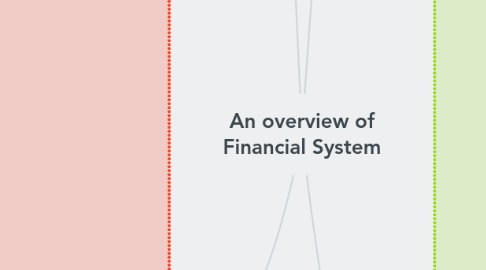
1. Internationalization of financial market
1.1. Foreign bonds: Sold in a foreign country and are denominated in that country's currency
1.2. Eurobonds: Denominated in a currency other than that of the country in which it is sold
1.3. Eurocurrencies: Foreign currencies deposited in the banks outside the home country
1.4. Eurodollars: US dollars deposited in foreign banks outside the US in foreign branches of US banks
2. Financial Intermediaries
2.1. The process of indirect finance using financial intermediaries/financial institutions and has traditionally been the primary route for moving funds from lenders to borrowers
2.2. Function
2.2.1. Lower transaction costs
2.2.1.1. Reduce the time and money spent in carrying out financial transactions
2.2.1.2. Increase economies of scale as the reduction in transaction costs per currency of transaction
2.2.1.3. Provide its customers with liquidity services, make it easier to conduct transactions
2.2.2. Reduce the exposure of investors to risk
2.2.2.1. Reduce risk through the process known as risk sharing (asset transformation)
2.2.2.2. Diversification: investing in a collection (portfolio) of assets whose returns do not always move together, with the result that overall risk is lower than for individual assets
2.2.3. Deal with asymmetric information
2.2.3.1. Asymmetric information: unequal knowledge that each party to a transaction has about the other party
2.2.3.1.1. Adverse selection: Problem created before the transaction occurs
2.2.3.1.2. Moral hazard: Problem created after the transaction occurs
2.3. Types
2.3.1. Depository institutions (banks)
2.3.1.1. Commercial banks
2.3.1.1.1. Raise funds to make commercial consumer, mortgage loans and buy government securities by issuing checkable deposits, saving deposits and time deposits
2.3.1.2. Mutual saving banks
2.3.1.2.1. Obtain funds primarily through saving deposits and time and checkable deposit and make mortgage for residential housing
2.3.1.3. Credit unions
2.3.1.3.1. Acquire funds from deposits and primarily make consumer loans
2.3.2. Contractual savings institutions
2.3.2.1. Life-insurance companies
2.3.2.1.1. Acquire funds from the premium that people pay to keep their policies in forces to buy government bonds, corporation bonds and stocks
2.3.2.2. Pension funds
2.3.2.2.1. Acquire fund by contribution from employers and employees. The largest asset holding of pension funds are corporate bonds and stocks
2.3.3. Investment intermediaries
2.3.3.1. Finance companies
2.3.3.1.1. Raise fund to issuing stocks and bonds by selling commercial paper to consumers and small business
2.3.3.2. Mutual funds
2.3.3.2.1. Selling shares to many individuals, use the proceeds to purchase diversified portfolios of stocks and bonds
2.3.3.3. Money market mutual funds
2.3.3.3.1. Sell shares to acquires funds that are then used to buy money market instruments that are both safe and liquid
2.4. Regulation of the Financial system
2.4.1. Increase the information available to investors
2.4.2. Ensure the soundness of the financial system
3. Financial market
3.1. Perform the essential function of channeling funds from economic player that have saved surplus funds to those that have a shortage of funds
3.1.1. Direct finance: in which borrowers borrow funds directly from lenders by selling them securities
3.1.2. Indirect finance: which involves a financial intermediary or financial institution that stands between the lender-savers and the borrower-spenders and helps transfer funds from one to the other
3.2. Function
3.2.1. Promote economic efficiency by producing an efficient allocation of capital, which increases production
3.2.2. Directly improve the well being of customers by allowing them to time purchase better
3.3. Debt instrument is a contractual agreement by the borrower to pay the holder of the instrument fixed amount of money (eg: bonds)
3.4. Equity instrument is a claim to share in the net income and the assets of a business (eg: securities)
4. Structure of market
4.1. Primary market: new issues of security, bond, stock are sold by the corporation or government agency borrowing the funds. Initial sale of securities is the investment bank
4.2. Secondary market: is market in which securities that have been previously issued can be sold. Securities brokers and dealers are crucial to a well-functioning
4.2.1. Organize exchanges: where buyers and sellers or securities/ their agent/ brokers meet in a central location to conduct trades
4.2.2. OTC market (over-the-counter market): Dealers at different locations and sell securities "over the counter"
4.3. Money market: Deal in the short-term (<1 year) debt instrument
4.3.1. Treasury bills: short-term debt instruments of the government issued to finance government spending
4.3.2. Certificate of deposit (CD): is a debt instrument sold by a bank to depositors
4.3.3. Commercial paper: is a short-term debt instrument issued by large banks and well-known corporations
4.3.4. Repurchase agreement, FED funds
4.4. Capital market: Deal in longer-term (>1year) debt instruments
4.4.1. Stocks: are equity on the net income and assets of a corporation
4.4.2. Mortgages: are loans to households and firms to purchase real structures or land itself serves as collateral for the loans
4.4.3. Corporate bonds are long-term bonds issued by corporations
4.4.4. Treasury bill are long-term debt instrument issued by government
4.4.5. Bank loans are loans principally to individual and businesses
